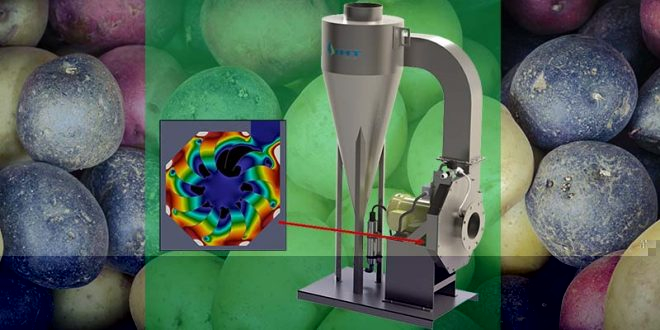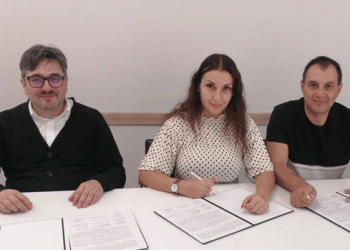For eight years now, Idaho Hydro Tech’s developed air scrubber, known also as the Humigator, cleans and humidifies the air in various potato storages around the world.
This air scrubber both disinfects and humidifies storage air. According to the producer, it stops the spread of Silver Scurf, Black Dot, and other airborne disease and humidifies to optimal levels – over 95% relative humidity (RH) while minimizing water usage and standing water.
The Humigator circulates the air in concert with the building’s ventilation system. Air passes through the air scrubber, goes through a series of dramatic pressure changes, and mixes with atomized water. These tiny water droplets move at high velocity, capturing the particles and pathogens in the air. The dirty water separates from the newly cleaned and humidified air. This clean, humid air blows back into the plenum, and the dirty water drains out for easy disposal.
“When properly sized for the installation, humigation is more than sufficient as the only humidity source whenever the storage is closed,” wrote the Idaho Hydro Tech’s experts.
When outside air is used for cooling, IHT’s Humigator size recommendations assume there is an evaporative humidifier as the primary humidity source. If a grower prefers to use Humigation as the only humidity source and uses high volumes of outside air for cooling, the company experts recommend careful vent modulation and a larger Humigator or combination of Humigators, especially in drier climates.
Extensively Tested
In 2018, the Humigator attracted the attention of Idaho State University’s Professor of Microbial Biochemistry, Ph.D. Peter P. Sheridan who extensively tested the ability of the air scrubber to remove mold spores, bacteria, and viruses from the air.
“Microbes were counted in the Humigator discharge water after each test. The counts were found to be very consistent. For Yeast Spores, this consistent count averaged approximately 1 x 105 spores per mL. This means a total of about 3.6 x 1010 (36,000,000,000) spores were captured by the Humigator. For bacteria, this count was over 10 times as high. This count averaged 1.04 x 106 bacteria per mL. Humigation reduced the average number of bacteria by over 80% on 33 of the 68 collection plates and reduced the overall bacteria accumulation by over 44%,” Sheridan explained.
The researchers admitted that they tested the machinery at “high” and “low” concentrations of organisms to further measure the limits of the Humigator.
“For the humigation experiments done at high concentrations of E. coli (around 109 bacterial per mL, using a 1000 mL culture), it is obvious that the Humigator was extremely effective in removing the aerosolized bacteria from the air in the test room. Our experiments using the yeast Saccharomyces cerevisiae (as a stand-in for common potato storage mold spores such as Helminthosporium Solani, commonly known as Silver Scurf) indicate that humigation is also effective in removing these particles from the air,” experts added.
“No Weight Loss”
According to Jef Viaene, responsible for Idaho Hydro Tech’s sales in Europe, the Humigator can be used for storage facilities up to 250 tons that have no ventilation and no climatization.
This air scrubber’s main advantage, according to Viaene’s announcement made for Potato Business, is that due to high humidity in the storage (up to 98%) there is potentially no weight loss.
“For farmers with a ventilation system, we have a machine for 1,000 tons, 2,000 tons, and 3,000 tons. Model 10 E for 1,000 ton ventilated or 250 ton not ventilated costs EUR25,000 FOB Brussels, duty USA paid. 2,000 tons is EUR30,000, and 3,000 tons is EUR35,000. The maintenance cost is near 0. It uses only water and electricity, and grease for the motor. The machine will run a minimum of 10 years without any cost,” added Jef Viaene for Potato Business.








